Our expert panel will take you through common misconceptions in PGT-M and PGT-A, covering technology, mutations, disorders, and the complexity in PGT-M design. We will also touch upon artificial intelligence versus subjective interpretation, CNV versus SNP, among others.
Misconceptions in PGT. Tacking and challenging the existing misconceptions in PGT-M and PGT-A.
In this webinar, Chief Medical Officer at Cooper Genomics, Mark Hughes discusses common misconceptions in PGT-M, while Director of Global Genomics Business Development, David Chrimes looks at the same in PGT-A.
Mark Hughes:
It’s hard to believe but this technology has now been around for 30 years and it involves mendelian or monogenic testing of embryos.
We’re going to talk about what this is with relation to monogenic/single-gene disorders and how it screens for a specific single-gene disorder.
We’ll also look at how it is for couples at high genetic risk of having a child with a disease (many of these couples aren’t infertile). PGT-M reduces the risk of passing on genetic diseases and therefore requires personalized test preparation and design.
We all carry lots of bad genes. We get some of them from our Dad and some of them from our Mom. We really have no idea that we even have them. We have two copies of every gene, usually the bad ones we get from our Dad aren’t matched on the other chromosome from the gene from our Mother, and vice versa. The only exception to this would be is if our parents were blood related which is of course why we have rules about this.
We blissfully go through life having no idea we carry bad genes until we have a child with someone who has a mutation in the same gene as we do. Now you have a one in four chance for an autosomal recessive disorder, which means having a baby with a genetic disease.
We all carry lots of these genes. We get them from our parents, who got them from your grandparents. They’ve been in the family for generations and unless you’ve had DNA screening or you’ve had a child with a mutation, or a family history of it, you don’t know about it.
About 1 in 28 or so of the patients who come to an IVF center, are at risk of having a child affected with an autosomal recessive or X-linked disorder. Unfortunately, the truth of the matter for many of these diseases, is that it’s “diagnose and adios” because there really isn’t much that can be done for most of them.
Every cell of your body has a problem with the gene and there just aren’t good treatments available. We all know about sickle cell, cystic fibrosis, Huntington’s and hemophilia but there are thousands of other disorders.
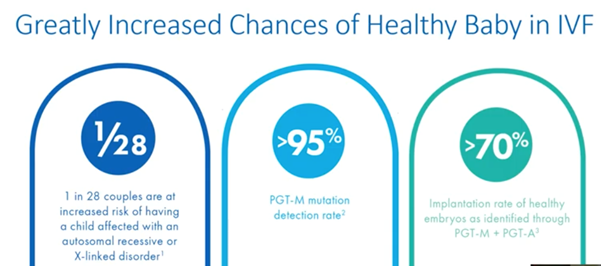
When you go through the process of IVF and PGT-M, your risk goes from one in two for a dominant disease (one in four for a recessive disorder) all the way to less than one in 20, which is a huge difference for patients.
These are not infertile couples. They’re coming to see you because they want to avoid throwing genetic dice, getting pregnant and hoping for the best and then having weeks of pregnancy wondering if their baby is affected or not.
PGT-M takes that risk from as high as one in two, (fifty percent) all the way down to about one in twenty, or better.
If you do on that biopsy, PGT-M for the disease and PGT-A for chromosome aneuploidy, every embryo transfer has about a 70 percent chance of producing a healthy baby. It’s a wonderful change in odds for couples.
The beginnings of all of this happened back in around 1990. There were people all around the world trying to do this. I teamed up with Alan Handyside, who many of us consider the father of pre-implantation diagnosis. At the time, he worked at the Hammersmith Hospital Royal Postgraduate Medical School in London and I worked with Robert Winston who was a clinician, and I was the geneticist.
We got together and did the world’s first case of PGD (pre-implantation genetic diagnosis) for a specific genetic disease. In this case, the cystic fibrosis gene had just been cloned. We decided to take a common disorder, use the new information on cloning and do the first case of PGD at the time.
It’s a funny thing because when we sent the abstract into the journal, we said ‘birth of a normal girl after in vitro fertilization and pre-implantation genetic diagnosis,’ but the journal made us change it to ‘testing’.
They said you’re not making a diagnosis; you’re doing a test. They forced us to put ‘testing’ and here we are all these years later, and the word PGD is no longer accepted. The universal phrase is now ‘pre-implementation genetic testing’ (in this case for monogenic disease) so the editors were right way back then!
Technologies have dramatically changed and we’re going to go over some of those today.
The sample has also changed because in those days, most clinics were transferring two pronuclei fertilized eggs because the culture conditions were so terrible back in 1990 compared to today.
Handyside was able to grow embryos to day three. We could biopsy them, but we had to get those embryos transferred later that day because growing to days four or five was incredibly unlikely to be successful.
Misconceptions in PGT-M
Unfortunately, after all the years I’ve been doing this (30 now), misconceptions about the technology still exists.
One of the misconceptions is that DNA sequencing is now pretty routine. People think because we’ve sequenced the genome that you can just take the DNA and the biopsy and send it to the lab. They throw it into a sequencer which chugs along all night long and voila, the next day you have a molecular answer.
Unfortunately, that’s not the way it works, it’s more complicated than that. Although we do sequencing, it’s a different kind. In today’s presentation, I want to make sure you understand the differences and why sequencing of the biopsy you send is not sufficient to do PGT-M accurately. You have to do something else called karyomapping and I’m going to talk about that as well.
One of the main reasons for this is that the sample you send only has four to six cells in it. It doesn’t have millions of cells like an amniocentesis, a CVS, a blood sample or a tissue sample. It only has a few so as we talk about genome equivalents, there isn’t very much DNA in there. DNA sequencing is very good, but it needs something to start with and even if you do PCR, it doesn’t get you around the problem of starting with such a small amount of material.
Also, the sequencing that you would do in order to look at a mutation would be incredibly expensive per sample. If you multiply that times six embryos, it would be very expensive for the couple. For those reasons, we use a different kind of sequencing.
Sequencing “Read Depth”
The image below shows a stretch of DNA.

DNA has a reading side called the 5 prime (5’) end. It reads along all these a’s, t’s g’s and c’s. Just for a bit of fun – if you were to type the human genome from one of these biopsy cells, not five of them, just one of them, in 12-pitch font into your computer, it would stretch 5,400 miles or about 9,000 kilometres.
If you could type 75 words a minute and were doing this for eight hours a day, it would take more than 50 years to type out the six billion letters in the human genome. You would also have a book with about a million pages or roughly 200 novels with 5,000 pages each.
You can think of those novels like chromosomes. They all have information about you but it’s one hell of a big book. Here’s just a tiny little section of some DNA and chromosome 4.
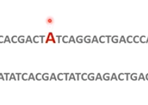
I put a mutation in the middle of this so you can appreciate that out of all these billions of letters of DNA, one little letter base change is all it takes to cause a disease.
DNA sequencing machines don’t work like people think. There’s a misconception that the enzyme jumps onto the DNA (DNA polymerase) like it’s a locomotive train and starts running down the track reading the DNA, going all the way until it falls off at the other end.
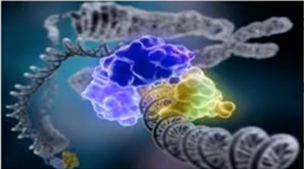
It would be nice if that was the case and there are some technologies on the horizon that might make this possible. At the moment however, this isn’t how sequencers work. What they do is sequence DNA in very small little pieces.

Firstly, not all of the enzyme stays on for a long way. Secondly, we break the DNA up into pieces from those little biopsies that you send. The sequencer only sequences that little bit. Then, the computer looks at that sequence and says, “that’s a phrase in book number four” or “that’s a sentence in book number six”, for example. You end up getting these tiny little pieces of DNA that go along. The longer you run the machine, the more of these little sequences you get.
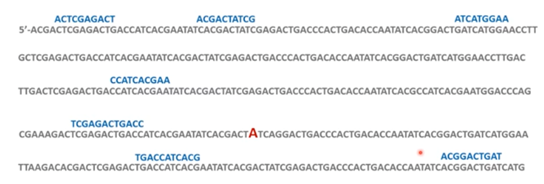
You can get a lot of information but the longer you run it, the more reagents you need and the more expensive the test is. In general, what we do is we have low/mid and high-resolution depth DNA sequencing. This would be considered a low or medium depth.
![]()
This is perfect for getting a “GPS” logistics on your sample. It’s not saying all the DNA has been sequenced, but enough of it has been sequenced to give you a bar and a barcode which tells you that “these pieces of DNA belong to chromosome four”, for example. This is useful in things like non-invasive prenatal testing in early pregnancy and in PGT-A.
However, it doesn’t necessarily always pick up the mutation. This means sequencing using these machines is unreliable. Remember, you’ve also got another copy of this DNA from the other parent, and you have to see them both at the same time.
So, low and mid-level sequencing read depths are okay for a lot of things but they’re not okay for PGT-M. It can tell us that this is on chromosome four but that’s about it.
![]()
Let’s focus on our mutation. Of all those nucleotides in the genome, this is the one that we’re really worried about.

WGS: Whole Genome Deep Sequencing
With more effort, you can do deep sequencing. This involves a sequence that keeps on going. You keep the machine running and as it runs, it makes more and more copies. The deeper you sequence, the more confidence you have in every DNA nucleotide.

If you notice, you’ve got a lot of overlap because you ran it for a long time. Some regions were sequenced twice in that particular run, some three times and others four times. In this example, our mutation was hit three times, so we start to gain confidence that it’s correct.

As I mentioned earlier however, this is expensive and when you’re doing it for six or eight embryo samples, it’s too costly for patients. Because of this, WGS is typically used for mutation hunting. For example, if you’ve got a child in the nursery and no one can figure out what’s wrong, you do deep, whole genome sequencing to see if you can find a mutation in a gene which suddenly gives you that “Aha moment” about what’s clinically wrong with the child.
It’s also very much used for clinical dilemmas, but it’s not used in PGT at all.
So, what is? Remember, in PGT-M, we know precisely what we’re looking for long before the patient begins IVF. We know the disease, the inheritance, family history and the exact mutation. We can create a test with this information which functions like a guided missile. It doesn’t sequence on a different chromosome from where the gene that’s of concern is. This is helpful when it comes to keeping the cost down and increasing accuracy.
PGT-M: Locus (mutation) specific focused sequencing
Here we have our mutation in this DNA again:

What we’re going to do is specifically sequence the mutation. To do this, we take some of the DNA out in front on the 5 prime end, and then down on the 3 prime end of the mutation. We make little artificial pieces of DNA which will allow a PCR machine to run back and forth and make millions of copies of the thing we’re particularly interested in.

This is what has been done for a very long time in PGT-M. The problem is, that’s not good enough either in today’s world. We really want to be accurate and with five cells, you better be sure that you saw that ‘A’ if it existed and that you saw the DNA letter from the other parent if it exists.
The genome lab creates a custom family test that only looks at these particular regions.
PGT-M: Single Nucleotide Polymorphisms (SNPs)
Below is our sequencing region. Don’t forget that we also have the other parent. Let’s say that this DNA running along here is Mom’s DNA, and this is the mutation that Mom carries (the ‘A’).

Every so often she’s got a letter in her DNA that’s different. Your DNA is different from everybody else’s unless you have an identical twin. That’s how the police can figure out if you’ve been at the scene of the crime. They can also do forensics or population migrations around the world. They use these polymorphisms/changes (“poly” meaning multiple, and “morphisms” meaning changes) of the DNA and they’re single letters so they’re called SNPs
Now let’s look at Dad’s DNA:
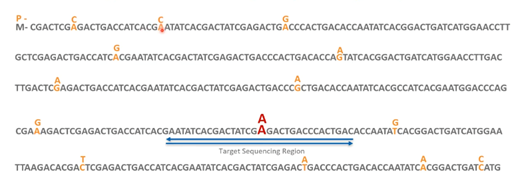
At some of these SNPs, he’s got a different letter. All the rest of these letters are the same in his sequence, but he’s got a different one. That’s great because each one of these is like a bar code and we can tell the difference between Mom’s strand of DNA and Dad’s strand of DNA.
We don’t determine this by looking at these letters, but by looking at the polymorphic differences. By doing this, we can be sure that when we do the test, we actually are looking at a strand of DNA in the embryo biopsy from both gamete donors.
You don’t want to have only Mom’s and see only ‘A’ and say, “well, Dad must have an ‘A’” when, in fact, what’s happened is the sample has maternal cell contamination (for example) or the sequencing reaction failed to see Dad’s DNA (for example).
Instead of having just one data point (the ‘A’ or not), we’ve got multiple data points which give us additional confidence that the biopsy sample actually has what we want it to have.
Mom’s and Dad’s DNA is different, and these differences allow us to follow both strands of DNA in each of the cells from the biopsy you sent. We can tell that we didn’t miss a ‘G,’ it actually was there. We can also tell that ‘G’ is associated with these other polymorphisms on the upper level.
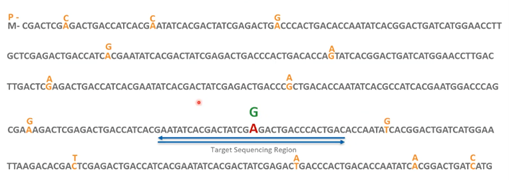
PGT-M: Utilizes SNP-driven linkage analysis
Because we have so many of them, we can follow them along. Let’s say here’s Dad’s DNA (top row) and here’s Mom’s (bottom row).

This is the centromere of the chromosome (the ‘C’ at the end of the row) and this is the telomere (the ‘T’ at the other end).
One of these individuals has a mutation in the gene. We can follow those little SNPs out in front of the gene, through the gene and out the back end both times. This means that we absolutely know that this is the strand of DNA associated with this. Even though these are tiny little pieces of DNA, each one is a little piece we’re sequencing. This all happens including re-combinations or genetic crossovers.
If you remember meiosis from basic biology, when the egg is still in the ovary, it’s doing a re-combination between grandma and grandpa’s chromosome that they gave to your parent. This means we can get mixing of the chromosomes across our family tree.
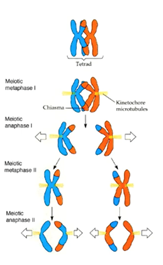
We can follow the pink which is the normal one here and we can see the crossover where it goes to the other one in that particular embryo.

This whole process is called karyomapping and it gives us much more confidence.
PGT-M via karyomapping technology
To summarize, we’ve got Dad who has a mutation and Mom who has a mutation. We have polymorphisms that we follow all the way along and that’s why laboratories ask for embryo samples from both parents as well as other family members such as grandparents and other children if they exist. If they happen to have the genetic disease, this allows us to link up the SNPs with the strand of DNA which has the mutation and the one that doesn’t.
We analyze the SNP samples surrounding the gene, making this a very powerful test. Finally, linkage analysis is used to determine the ‘genetic fingerprint’ of the mutation and diagnose each tested embryo as affected or unaffected.
The other misconception in PGM-T is that since sequencing is quite routine, all the embryology lab has to do is perform the biopsy, ship it to the lab and they’ll do the test. I hope from this talk, you realize that’s not the case. It is true in PGT-A, but not for PGT-M where you have to do some homework beforehand. You need to communicate with the laboratory, you don’t just send samples.
Another misconception is that we can do this for all genetic diseases. This misconception isn’t too far off because we can if we know the molecular basis of the disease. If you call and say can you do PGT-M for autism however, the answer would be no. This is because there are a lot of genes which have been loosely associated with autism, but none specifically. This means we don’t have anything to send our missile to, we don’t have a target to do our homework on.
There are diseases (polygenic diseases), that only happen with multiple gene defects. If we know what’s causing the disease and what the mutation is and this is fairly straightforward to find in the family, then the test can be designed.
This has been shown to be true because over 6,000 different single-gene disorders have now been tested for, including things like inherited cancers. Most cancers are not inherited (only about 10 percent are), but PGT-M has been performed for breast and ovarian cancer through the BRCA mutations quite regularly. This has also been done for cystic fibrosis, fragile x syndrome, spinal muscular atrophy, Huntington’s disease and sickle cell. These are the most common diseases in the United States and Europe.
If you’re from South America, Mexico or Asia for example, we wouldn’t be thinking about cystic fibrosis at all. That’s a rare condition because the gene isn’t prevalent in those populations. It really depends where the family lives. Because we perform these tests all around the world, we’ve had to develop them for many families.
We cannot test for disorders that are associated with mutations in mitochondria and we can’t do it for genomic imprinting either. It’s unlikely that any of you are going to see any mitochondrial or genomic imprinting disorders anyway.
Do you always need family members to build a PGT-M test?
Traditionally, yes but technology and innovation has moved on and now I can say, not always.
Let’s take this example. We’ve got Dad here (the square in the image below) and let’s pretend he has a dominant disease.

He has a mutation in one of his two chromosomes which let’s say he got from his Mother. He wants to have children with his mate (the circle in the image above) and maybe he’s been adopted (so we don’t know anything about the previous generation), or maybe his parents have died, or they’re estranged, or he wants to keep this all private so doesn’t want to tell them. Perhaps he doesn’t have a brother or sister with the same disease, and they don’t have any children with it.
How are you going to connect the SNP strand of DNA with the mutation strand of DNA if you don’t have anyone other than his two chromosomes to link it to?
In the image below is Dad.

We’re going to give him a ‘G’ and a ‘T’ and we’re going to call the ‘T’ the mutation. There’s a 50-50 chance if he gives the ‘T’ in his sperm, that the embryo will have the same disease. If he gives the ‘G,’ then the baby won’t have it.
Mom has got two different letters and her two copies of the gene – one from each of her parents and both of those are normal. We don’t want to just do sequencing. We want to be sure that if the ‘T’ is present in the embryo, we actually see it and we don’t think there’s two ‘G’s, for example.
If we look at that the way I showed you in the previous slide, we want to be able to see the ‘T’ and we want to be able to see the linkage (the SNPS), on each side of that gene for both Mom and Dad.

How are we going to do that if we don’t have anybody else in the family? What we can do is look at their embryos. Pretend that their embryos are six children in the family and now they want to have more. We’re going to test these embryos through DNA sequencing and SNP analysis. This will help us solve the puzzle about how the SNPs and the mutation are linked to one another after we collect the data instead of before. Although this isn’t ideal, it does work quite well.
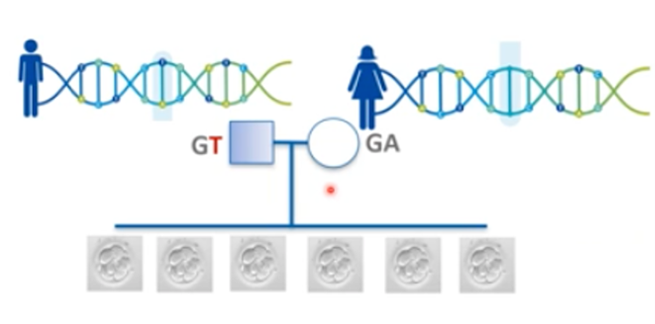
We look at the first embryo and see a ‘G’ from dad which is normal and an ‘A’ from mum. We know that the embryo has that set of SNPs, but we don’t know anything about the mutation yet.
In the next embryo, we know that the ‘T’ is present and that it’s associated with a different set of SNPs, a different haploblock, a different allele strand, a different bar code or fingerprint, any of those words work.
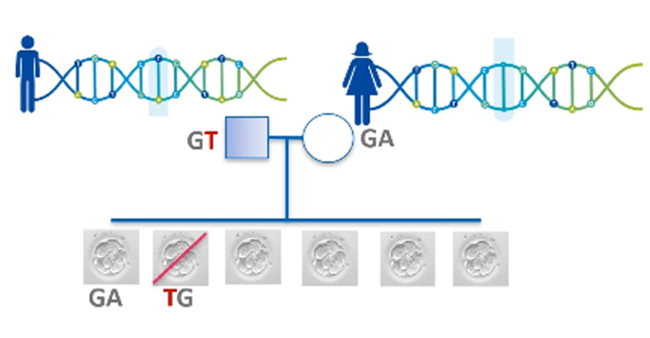
Then we look at the next embryo and see the same polymorphisms. We work our way down the row and every single time we see a ‘T’ in our little missile-guided sequencing, we also see the same SNPs that are associated with it.
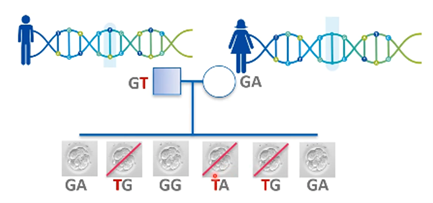
If we’ve done that several times in several embryos, we’ve linked the SNP set with the mutation. Then we can have a lot of confidence that not only is our sequencing working correctly in this particular family, but that we’re also getting consistent results across the entire group of embryos.
This is the kind of work you have to do in order to be sure and you want to be sure, of course, in these cases.
We can develop a test using affected embryos. It’s not ideal, however and we need at least three affected embryos in the cohort to do this. It is very doable though and it’s mostly suitable for de novo mutation cases.
PGT-M and Microdeletions
We also hear the misconception that PGT-M isn’t suitable for microdeletions. This simply isn’t true.
If you can follow polymorphic markers across a piece of DNA, and you can show that those markers are missing in samples that have a microdeletion (that the fingerprint is half there during the microdeletion part of the sequencing), then you can molecularly brand that strand of DNA (if it’s normal or microdeleted) and follow it in the embryos.
This is done all the time so anybody that tells you it’s not possible probably isn’t using cutting edge technology.
PGT-M Summary
To summarise:
- We can accept even the most complex PGT-M cases
- We’ve been doing this for 30 years We’ve got lots of experience and expertise.
- We’ve performed PGT-M for more than 6,000 single-gene disorders
- We can run PGT-M plus PGT-A simultaneously
- We have all of the certifications that one could possibly want including CLIA, CAP, ISO and we’re New York State Approved
***
Misconceptions in PGT-A
David Chrimes:
PGT-A is Preimplantation Genetic Testing for aneuploidy. Previously, this was called PGS (Preimplantation Genetic Screening) or CCS (Comprehensive Chromosome Screening).
The good news for those was that they actually had the word screening in the name. That’s very important because it is a screening test, not a diagnostic test. It screens the chromosome abnormalities and the meiotic errors (i.e., errors originating in the oocytes).
It has a very high accuracy of 97 percent (or greater). If the trophectoderm biopsy says it’s euploid, this means the inner cell mass is euploid in 97 or greater cases, and the same for aneuploidy. So, it’s a very good screening test.
Another good thing about PGT-A is that it’s an option for all IVF patients. It doesn’t require any kind of personalized test prep or medical history. Whether you choose to offer PGT-A to the patients, is up to the patient and the clinicians in discussion. It does improve IVF success rates however, especially for those in the over-35 age bracket.
PGT-A has been shown to improve IVF outcomes. One of the first studies showed that it mitigates the effect of maternal age. By that, we mean that with a good embryo (a euploid embryo), we pretty much have the same success rate for embryo transfer with an advanced maternal age, as a young female patient.
This is because it reduces miscarriage rates to background levels. It does not eliminate miscarriage however and it shouldn’t be seen as miscarriage elimination. It certainly does reduce rates though and it also increases the implantation rates per embryo transfer.
Combining increasing implantation rates with the reduction in miscarriage rates, we’re increasing our live birth rates per transfer. By using PGT-A to prioritize embryo transfer, we also have reduced time to pregnancy. What it has also done is enabled much more confident single embryo transfer, especially in the advanced maternal age.
Where there was always the temptation to try and increase the number of embryos put back to try and ensure at least one of them was a successful pregnancy, we don’t need to do that with PGT-A.
New advances of the PGT-A platform: PGTai 2.0
What is equally important, is the accuracy of the test. Recently we launched PGTai 2.0 which you can find out more about in our webinar entitled “Explore PGT-A using our revolutionary PGTai technology platform”.
With increased sequencing, we can now do a much more accurate assessment for the ploidy and mosaic status of the embryo. With parental DNA for the highest accuracy, we can detect all forms of ploidy (e.g., female haploid and female triploid). We can test whether that aneuploidy is from maternal or paternal origin and we can also do the 2PN validation. So, if it’s not triploid or haploid, it’s diploid. We can also see the heterozygosity and show that it’s 2PN.
Data quality of PGT-A: Artificial Intelligence (AI) vs Subjective Analysis
I’ve been in PGT-A for 12 years now and I’ve seen a real explosion in technology from where we started. From polar bodies and 24sure chromosomal arrays, through to trophectoderm and now four million paired end sequencing reads.
All the way through this, transfer prioritization decisions were based on the PGT-A results in part.
What we now have, using AI, is the ability to use high-power statistical analysis from a baseline that includes live births and sustained pregnancies as well as known aneuploidy embryos that have been shown to be completely aneuploid by secondary methods.
This allows us to baseline all of our decisions for the embryo being tested using high power statistics against those matched profiles. And, because for each embryo tested, we’re using these high power statistics, we remove user bias. There is no, ‘did I see this yesterday?’, ‘Does it look like one I saw two weeks ago?’ or ‘How do we report that?’ It’s all computer-based and that gives us great repeatability.
In addition, because we still track outcome data, we can now build incremental improvements. The more data we have to feed into the known outcomes, the better that will become. This is the great advantage of artificial intelligence.
PGT-A Detection Ability
Even with PGTai 2.0, we still have a limitation of detection ability and it’s important that the patients and clinicians understand the limitations of the PGT-A technology.
PGTai 2.0 can detect chromosomal changes which have always been done. Now we can get down to 5Mb with high accuracy. This is obviously very important for the PGT-SR (structural rearrangement) which often involves small telomeric segments.
As I’ve said, we can do the mosaic changes and the parent of origin. What this doesn’t say is what we can’t detect, and this is equally important. We can’t detect anything below 5Mb. Although these are rare, they can happen and sometimes they’re clinically relevant.
I’ll just pull out one as a highlight, which is the DiGeorge syndrome. This is a microdeletion, a chromosome 22q11.2 and that’s quite often 250kb or smaller. It’s usually de novo, so no inheritance and this would slip below the detection threshold.
When talking to patients, it’s very important that we understand that PGT-A is not going to detect every possible chromosomal and genomic abnormality in that embryo.
Mosaic Embryos Self-Correct
Can an abnormal embryo self-correct? There has been a phrase, ‘mosaic embryos are self-correcting’, banded around but is this actually true?
First of all, what do we mean by self-correction? Is it a meiotic error which results in a normal embryo or a mitotic error – a mosaic embryo which results in a healthy live birth, or a combination of the two?
To have a meiotic error, there would have to be a non-disjunction error leading to either a monosomy chromosome or a triploid chromosome. If it was a triploid (e.g., trisomy 15), there would have to be a successful remover of the extra chromosome from all cells. With the remaining two being from one parent.
Theoretically, impossible. However, in a UPD that we see in live birth, even from a normal pregnancy, we can’t track whether that is what happened or if it was simply that one of the oocytes had both copies of that chromosome and the corresponding oocyte didn’t have it at all, and it has just gone on and formed a pregnancy. There is no real way that this has been managed to show the mechanism for ending up as a UPD.
If it was a monosomy, the cell would have to undergo duplication of that chromosome prior to cell division so that it’s populated throughout all the cells and all of the embryo. Again, we haven’t really got evidence for this.
We know there have been reports that mosaic embryos have been transferred and have resulted in what appears to be healthy live births. We know they have reduced implantation potential and higher miscarriage rates, but some make it to live birth. How is that possible? Is it undergoing self-correction?
What we do know with imaging, is that mosaic embryos have a higher rate of cell death and therefore it would appear that the embryo is in some way, able to have the abnormal cells. They undergo apoptosis, leaving the euploid as the dominant or only cells left. But as that mosaic load increases, the amount of cell death required for that to happen becomes detrimental to the embryo survival.
Is that self-correction? You could argue it is but really it seems that abnormal cells are more likely to undergo apoptosis than euploid cells.
Does PGT-A Guarantee a Healthy Baby?
No, much like PGT-M, PGT-A does not guarantee a healthy child. As I stated earlier, it’s a screening test rather than a diagnostic one.
Equally, you can have confined placental mosaicism and other conditions where the trophectoderm biopsy (which ultimately goes on to form the placenta) is euploid but the inner cell mass is aneuploid in some way. Because of this, ACOG and ACMG recommend that all women, even after PGT-A, should undergo the usual prenatal screening tests, including the option of an invasive diagnostic test during pregnancy.
Non-invasive PGT: Where are we?
There has been a lot of discussion around non-invasive PGT recently so where are we with that?
There have been quite a few papers published over the last few years and overall, it shows that the embryology is critically important for success. This means you absolutely require single embryo culture from day three or four. If you’re a clinic that believes in group culture, this is obviously a potential issue.
You also have to wash the embryos through various media droplets at day three or day four. Again, if you’re doing things like time lapse or uninterrupted culture, this could prove a barrier for non-invasive PGT.
The low media droplets probably have to be smaller than 20 microliters. For some, that’s fine and for others it may raise questions, depending on their incubators.
The one thing that all the papers have shown is that to get really good results, you need to have the embryos in that media culture for at least 48 hours.
Across all these studies, the overall concordance to invasive PGT-A is variable. Now that PGT-A is so well-established and people have outcome data for euploids, aneuploids and mosaics, it’s really driving the question about how applicable the results are that you get for non-invasive PGT-A and how close in concordance they need to be. There are still issues of maternal contamination to be resolved.
After fertilization, you’ve got the polar bodies being excluded and you’ve potentially got cumulus cells releasing DNA into the media. It has been shown that a lot of the false positives are actually female euploid, which is actually maternal cell contamination and not the embryo.
Summary
In summary, PGT-A remains the best available tool for assessing the genomic status of the embryo. It has been reported numerous times that euploid embryos have the highest success rates and that mosaics have a lower implantation potential.
PGT-A will continue to develop with more sequencing, more data and more accurate results. However, it’s just one of the tools in the embryo selection portfolio. There’s also morphology and various other aspects which will almost certainly influence the outcome of those embryos.
About Mark Hughes
Mark graduated in Biology and Chemistry from St. John’s University. Following this, he completed a masters in Biophysics at Stanford University and a Ph.D. in Molecular Biochemistry at the University of Arizona Medical Center.
He continued his training at the Baylor College of Medicine in Houston as a postdoctoral fellow with Bert O’Malley, where his pivotal work was published in Science and Nature.
Following his training, Mark completed his M.D. at Baylor, followed by house staff training in Internal Medicine and Clinical Subspecialty Training at Duke University. He then returned as junior faculty to Baylor’s newly formed Genetics Institute.
Among his accomplishments, was the realization that single cells could be molecularly data mined for diagnostic advantage. This led to a multi-year collaboration with reproductive endocrinologists and embryologists at the Hammersmith and UCLondon. It was here that the field of Preimplantation Genetic Diagnosis was born.
In 1993, Hughes’ research was recognized by Science magazine as being one of the “ten most significant advances” in science that year.
Read more about Mark Hughes.
About David Chrimes
David is a PhD molecular geneticist with 14 years of experience in molecular diagnostics.
In 2016, he started working at Genesis Genetics to help drive advances in their embryo testing. After the acquisition of Genesis Genetics by CooperSurgical Industries (USA) in 2016, Dr Chrimes took on a global role as Director of Global Genomics Business Development.
This role enables him to drive innovation in genomic testing and also gain regular insights into the challenges faced by IVF clinics today.
Read more about David Chrimes.
Find out more
The following are mentioned throughout the text above and/or are particularly relevant to it. To find out more about each item, please click the link.
- Reference
- Procedures
- Tests

 My Clinic is in the United States
My Clinic is in the United States My Clinic is in Canada
My Clinic is in Canada


